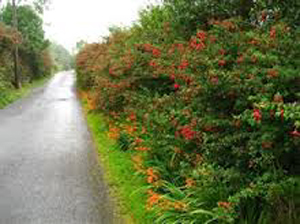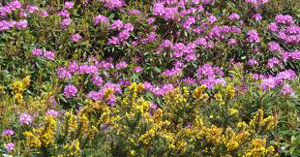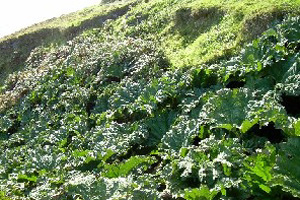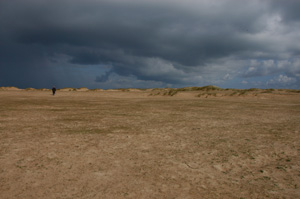An interesting feature of the Achill landscape are the areas of machair – flat, extensive plains of wind-blown sand which develop behind sandy beaches. Machair consists of a mixture of sands derived from the shells of animals which lived on the offshore platform and from glacial tills. Machair beaches are often found between outcrops or in small bays between headlands.
The upper limit of the beach is usually marked by a pebble or cobble ridge behind which there are dunes. Behind the dunes is usually a gently sloping plain whose degree of flatness is a reflection of age. The level of the machair plain is controlled by the underlying water table. This is the reason that many machair areas are flooded during winter. Machair is a completely vegetation covered coastal plain, lyme and marram grass being the most common varieties found. This phenomena is unique to the north-west coast of Ireland and parts of Scotland. There are three areas of machair on Achill, at Dugort, Valley and Keel. This rare habitat is of special scientific interest and is protected by EU directives.
Two-thirds of Achill is covered by peat bog, and this probably accounts for the relatively low number of plant species native to the island. The most common species is heather. Achill’s location as one of the most westerly islands in Europe, and the climatic effects of the Mexican Gulf Stream, provide a very special environment for flora and fauna. The hilly landscape features endless stone walls and heather-speckled moors, contrasting in some sheltered places with the jungle green vegetation of fuchsia bushes and giant rhubarbs. Much of the island is grassland, which is generally species rich. There are area's of Silverweed, Clovers and Sedges . Other species include Primrose, Bird's-foot trefoil , Dog Violet and Lesser Celandines. Some of the grass fields have been invaded by Bracken and Brambles and some Gorse. In areas of poor drainage, patches of Rushes and Yellow Iris's.

Gunnera tinctoria is currently considered invasive on the west coast of Ireland, although it is also found on the east coast to date it is not considered invasive. It is considered to be having a significant impact on Achill Island, where is has spread throughout. It is thought it was originally bought over as an ornamental plant; first records of it are as far back as 1939. Its native range is mainly from southern Chile, where climatic conditions are similar to those found on the west coast, high annual rainfall and temperatures rarely falling below 0º C. In Ireland it is now found on coastal cliffs, waterways, roadsides, wet meadows and derelict gardens and fields. It propagates both by seed and by vegetative means. In early spring its leaves begin to grow and in a couple of weeks can reach over 2 meters in height. Its large leaves (up to 2m wide) and fast growth shade all plants growing below.

